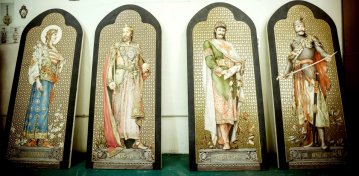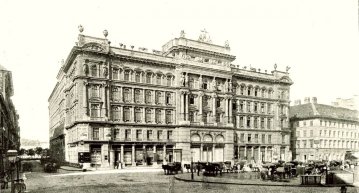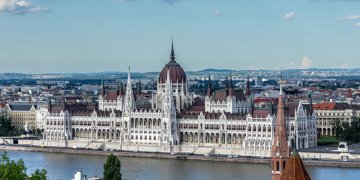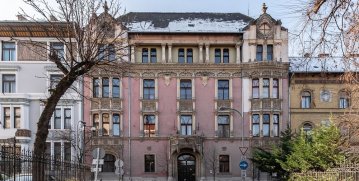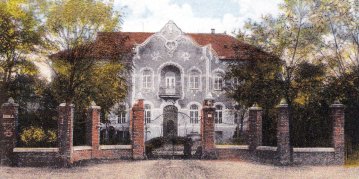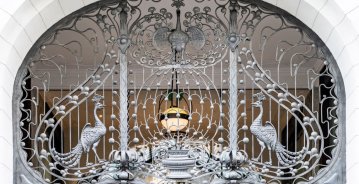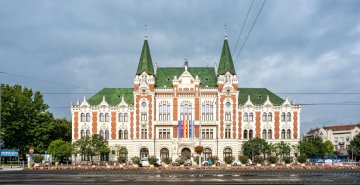
Tudós-Takács Ernő
Cikkek
From the Opera House to the Parliament - The decorative painting of several representative buildings is the work of Róbert Scholtz
July 5, 2021 at 9:30 AM
Ornate public buildings and palaces were defining parts of the cityscape of Pest-Buda, which became a more and more civilized city and a metropolis. Róbert Scholtz, a decorative painter, played an important role in decorating many representative buildings, and his work is famous for, among other things, the St. Stephen's Hall, which was destroyed in 1945, but will soon be rebuilt.
Painter of saints and kings – Twelve works by Ignác Roskovics adorned Saint Stephen's Hall
June 14, 2021 at 9:00 AM
Ignác Roskovics was one of the popular painters of the last decades of the 19th century and the turn of the century. Among the ecclesiastical and historical works that define his oeuvre, the twelve paintings made for the St. Stephen's Hall in Buda Castle stand out, based on which ceramic paintings were made in the Zsolnay factory. The works, ten of which depict the most important kings and saints of the House of Árpád, and two depict scenes from the life of St. Stephen, will be on display again from 20 August in the recreated St. Stephen's Hall.
The imposing palace of Vörösmarty Square – Headquarters of the world-famous Haas Fülöp & Sons Company
April 29, 2021 at 9:00 AM
Fülöp Haas founded the most high-quality carpet manufacturer in the age of dualism in Vienna. The company, which later became world-famous, had two factories in Hungary and a central department store and warehouse in Budapest: one of the most beautiful palaces of today's Vörösmarty Square. The company, which made the production of carpets an applied art, also made the ornate wall tapestry of Saint Stephen Hall in the Royal Palace of Buda Castle, which will soon be reborn in the reconstruction.
The iron founder Ignác Schlick was born 200 years ago – His Factory built the Dome of the Parliament Building
April 17, 2021 at 10:00 AM
The factory he founded played an indispensable role in the development of the Hungarian capital, as he made the iron structures of many emblematic buildings: the dome of the Parliament, the Opera House and the Hungarian Academy of Arts and the Museum of Applied Arts, as well as the glass-iron facade curtain walls of the Nyugati (Western) and Keleti (Eastern) railway stations. The Deák statue in Széchenyi Square was also made in his foundry. Although Ignác Schlick may be known to a few, his work is often forgotten in the development of Budapest.
A Master of Art Nouveau – Remembering Zoltán Bálint
March 11, 2021 at 11:00 AM
Zoltán Bálint was born 150 years ago and played a significant part in redefining Budapest's architecture, but his name is little known today. His prolific oeuvre, his work with fellow architect, Lajos Jámbor, elevates him to an unavoidable position in Hungarian Art Nouveau architecture.
Sanatorium, hospital and military installation – Art nouveau North Pest Hospital awaits rescue
February 9, 2021 at 10:00 AM
When completed in 1903, the North Pest Hospital – part of Pestújhely at the time – was the only Art Nouveau hospital complex in the country. Opening as the Niedermann Sanatorium, the building later housed a workers' hospital and then became a military complex used by occupying Soviet forces. It was used as the central health institution to serve soldiers stationed in Hungary. The Art Nouveau main building now provides specialist care for outpatients, but most of the more than thirty structures are unused, abandoned and dilapidated – despite nine of them being listed historical monuments.
A master of beautiful gates – Works by Gyula Jungfer adorn public buildings around Budapest
January 20, 2021 at 10:00 AM
A walk around the representative public buildings of Budapest is almost a walk to visit the major works on GyulaJungfer. The artist that reimagined ironworking in Hungary and elevated it to an applied art was born 180 years ago. His work still defines Budapest.
Újpest City Hall 120 years old
August 22, 2020 at 9:00 AM
One of the symbols of Újpest, the town hall, which was inaugurated 120 years ago, on 21 August 1900, was designed by the outstanding architects of the age, Ármin Hegedűs and Henrik Böhm. Originally a town hall and then city hall from 1907, the historic building, which bears Art Nouveau features, is still in the service of the local population.


